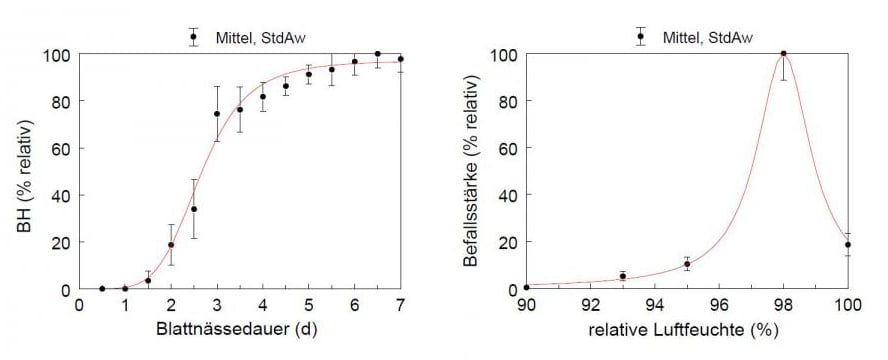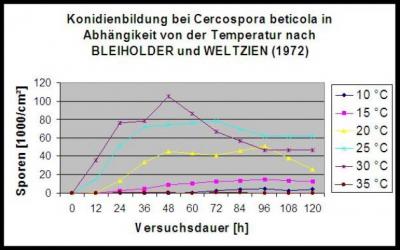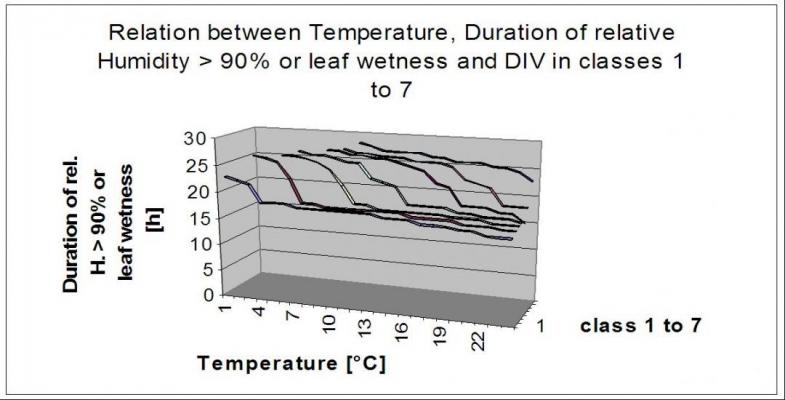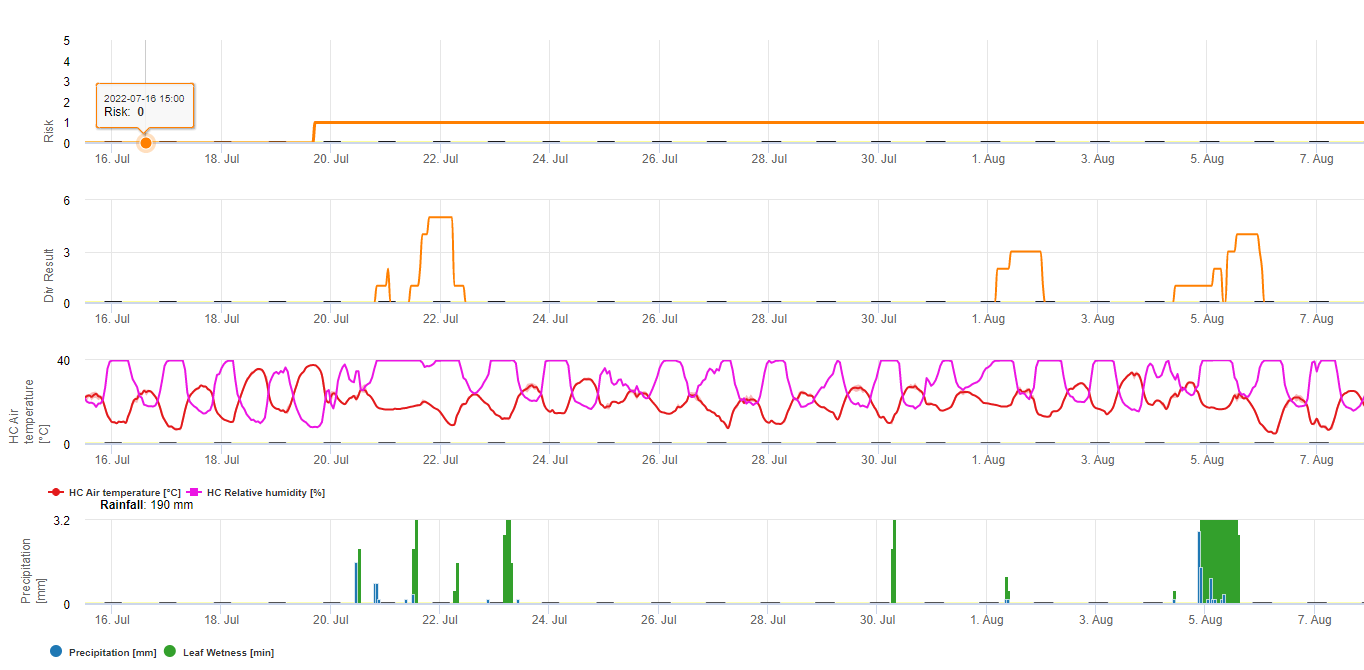
Sugar beet disease models
In the nineteenth century, farmers had already learned that the yield of sugar beet decreased steadily when beet crops were grown repeatedly in narrow rotations. Schacht showed in 1859 that this damage was caused by beet cyst nematodes, Heterodera schachtii, a parasite which has been a limiting factor in beet production until the present day. There are other nematodes that cause considerable damage in sugar beet but H. schachtii is the most important one. The insects Atomaria linearis (pygmy mangold beetle), Agriotes obscures (wire worm), Tipula paludosa (leatherjacket), Chaetocnema tibialis (fleabeetle) and Onychiurus armatus (springtail) cause seedling death. Sucking damage to the seedling leaves is caused by Calocoris norvegicus (potato bug) and Piesma quadrata (rape leaf bug). Pegomyia betae (beet fly) is a leaf mining insect.
Important viruses are Beet necrotic yellow vein virus, causing the disease Rhizomania, which is vectored by the fungus Polymyxa betae, and Beet mild yellows virus which is vectored by the aphid Myzus persicae. Major soil-borne fungal diseases in sugar beet include Rhizoctonia solani, Aphanomyces cochlioides, Fusarium spp., and Verticillium dahliae. Above-ground, sugar beet leaves are attacked by Erysiphe betae (mildew), Uromyces betae (rust), and the leaf spotting pathogens Ramularia beticola and Cercospora beticola.
Cercospora leaf spot
Damage by and prevalence of Cercospora beticola
In severe epidemics, CLS causes progressive destruction of leaves, followed by a continual replacement of new leaves at the expense of stored reserves in the root, leading to a reduction in yield and sugar content. In the Netherlands, yield reductions of up to 21% in sugar yield (sugar content x root yield) and 23% in financial return were observed (this thesis), but for individual beet fields, sugar yield reductions of up to 40% have been observed. This results not only in less income for farmers, but also for the sugar industry as extractability of sugar is less with infection by CLS. The percentage of beet fields in the Netherlands in which a CLS infestation is observed has increased from 13% in 2000 up to 32% in 2002. Consequently, the percentage of beet fields in which a fungicide spray against C. beticola was applied increased from 9% in 2000 up to 23% in 2002.
The fungus Cercospora beticola
Cercospora beticola Sacc., causal agent of Cercospora leaf spot (CLS) in sugar beet is the most common and destructive foliar disease of sugar beet worldwide. The fungus belongs to the class of Fungi Imperfecti (Deuteromycetes), order Moniliales, family Dematiaceae, section Phaeophragmosporae. Hyphae are hyaline to pale olivaceous brown, intercellular, septate, 2-4 μm in diameter, and form pseudostromata in substomatal cavities of the host from which conidiophores are borne in clusters. Conidiophores, emerging only from host stomata, are 10-100 (mostly 46-60) μm x 3-5.5 μm and unbranched, with small conspicuous conidial scars at the geniculations and the apex. Conidia, 20-200 x 2.5-4 μm (mostly 36-107 x 2-3 μm), are smooth-walled, straight to slightly curved, hyaline, acicular, and gradually attenuated from the truncate base, with 3-14 (sometimes up to 24) septa. No teleomorph stage of C. beticola is known at this moment.
Epidemiology and life cycle of Cercospora leaf spot on sugar beet
The symptoms of Cercospora leaf spot (CLS) consist of delimited, circular spots which develop on older leaves, and enlarge to 2-5 mm when mature. Lesions are tan to light brown dark with brown or reddish-purple margins. Elongated lesions occur on petioles, and circular lesions may occur on sugar-beet hypocotyls not covered by soil. Individual spots on the leaves coalesce as the disease progresses, and large areas or leaves become brown and necrotic. Minute black dots, pseudostromata, are often visible in the center of mature lesions. Under humid conditions, conidiophores are formed on the pseudostromata, and the leaf spots become grey and velvety with the production of conidia. Blighted leaves eventually collapse and fall to the ground but remain attached to the crown. The younger heart leaves are usually diseased later than older leaves. All above-ground parts of seed plants including seed clusters, can be affected.
Cercospora beticola is inactive at temperatures below 10°C, and can infect between 12-37°C. Optimal temperatures for conidia production are between 20-26°C if the relative humidity is in the range of 98-100% or at 25°C. Severe epidemics can be expected when the relative humidity stays above 96% for 10-12 hours each day for 3-5 days and the temperature remains above 10°C. Despite these rather high temperatures, severe epidemics of Cercospora leaf spot can develop in the Netherlands. Conidial release is effected by rain and dew (Meredith, 1967) and conidia are mainly disseminated by rain-splash, and less efficiently by wind, irrigation water, insects and mites.
BeetCast
If we apply BeetCast, we can do this on base of the high impact of relative humidity and leaf wetness on the epidemics of C. beticola, what has been found again by Wolf P.F.J. et al (2001). The results of this researcher team is displayed in the two graphs at the right side of this article.
Disease Severity Evaluation Model:
This model is calculated at the end of a day 11:30pm. The model calculates and compares the disease severity values following the tables below.


BeetCast Prediction rules:
To come to rules for fungicide application Beetcast is combined with the output of the CercoPRI model. It could be the prognosis of the first spray by the Pessl Instruments Risk model or by the DIV model to be used in the same way.
• Where CercoPRI reaches threshold before 01.06. apply first fungicide when 55 DSV units are accumulated repeat spray when 35 DSV units are reached again
• CercoPRI reaches treshold before 01.07. apply first fungicide when 70 DSV units are accumulated repeat spray when 55 DSV units are reached again
• CercoPRI reaches treshold after 01.07. apply first fungicide when 80 DSV units are accumulated repeat spray when 55 DSV units are reached again.
Pessl Instruments C. beticola Risk model
Bleiholder and Wetzien 1972 where looking deep into the reproduction of C. beticola. They found the pathogen to be well adopted to warm climate. Latency period and sporulation was strictly temperature dependant and the temperature optimum was found to be quite high. The findings of Wolf, P.F.J. et all (2001) where very similar to those of Bleiholder and Weltzien (1972). At temperatures below 14°C incubation period becomes longer than 14 days. If temperature undergoes 10°C there is very few progress in fungal development and at 5°C no fungal development is visible at all.

This explains the late occurrence of the pathogen in the sugar beet fields in cool climate. Looking for publications made in the actual century we will find even for cooler places that C. beticola can be found to the end of June. Going back to the seventies and eighties of the last century C. beticola was found in this places during July and first sprays had to be applied at the end of July and the beginning of August.

Bleiholder and Weltzien where looking for the impact of temperature on conidia formation too. They found very few conidia formation below 15°C but an optimum of 25°C and 30°C. Wolf et al (2001) where looking for the germination and they found optimum temperatures at more than 22°C.
The simple risk model uses this findings to evaluate if we can expect C. beticola at all. For this it looks first if the incubation period could be fulfilled within the last 2 weeks. If yes we get 100% of incubation if not the percentage of incubation within the last 2 weeks will be below 100%. Beside of the incubation model the risk model uses a model for sporulation. Optimum Conditions of 48 hours of high relative humidity with an average temperature of 30°C is used as 100% sporulation.
The risk is 0 if the incubation period has been found to be longer than 2 weeks. If this is not the case the model output will be 1. If there is a sporulation model result of higher than 10% calculated within the last week the risk will be shown to be 2 and if the sporulation result is higher than 30% the risk will be outputted to be 3. If we are looking for the model result, here for the year 2010 for an iMETOS located in Styria Austria we can find the risk model displayed together with the DIV model. Both models will indicate the first reasonable risk and the first DIV values accumulated to 6 on two consequent days for the middle of June. This would indicate the first spray for susceptible varieties on this site. Moderate susceptible varieties could be sprayed a little later best in the beginning of the next period with high risk and DIV values.
DIV model following Shane and Teng
Wolf P.F.J. et al (2001) were looking for the influence of moisture to the epidemiology of C. beticola again. Their findings are very much similar to the findings of other researchers before. Shane and Teng (1985) formulated their Cercopsora Model on base of the humidity needs of the disease. The DIV model is looking for the hours with relative humidity higher than 85% or with leaf wetness. On base of the number of hours and the average temperature during this period it points out a DIV (daily infection value) for this day. Depending on the susceptibility of the variety an accumulated div value over two consecutive days of 6 or more will indicate the need of the first spray. If we have more resistant varieties will can wait for higher accumulated DIV values on consecutive days. In our example below we would spray susceptible varieties in the middle of June and more resistant varieties we could wait until the middle of July.

CercoPrim
This model estimates the date of the first occurrence of C. beticola on base of the accumulated daily average temperatures since the first of January over 5°C. It takes threshold of 1006.2°C in periods with relative humidity higher than 60% and if we would have no relative humidity a threshold of 1081.9°C is valid.
This model have been developed for Italy and is used in Italy and Germany.
For the year 2010 in Styria CercoPrim indicates the 19th of June for the first spray. This is approximately the same date the Pessl Instruments Risk model or the DIV model would have indicated to spry susceptible varieties.
Practical use of the C. beticola models
All three models are indicating periods of risk for Cercospora beticola. The model checking if the incubation period of Cercospora beticola can be fulfilled within a fortnight will be helpful in spring and early summer to indicate an early appearance of this disease like it happens in many parts of Europe in the season 2000. The check for sporulation possibilities and the risk model using incubation period and sporulation possibilities will indicate periods of high disease pressure in the running season like the DIV infection model from University of Minnesota Crookston. The DIV model indicates a spray when we have had 2 consecutive days with DIV values of 6 or higher. Combining the DIV model with the output of the CercoPrim model gives an indication when we have apply the first spray and when a spray should have repeated.
Recommended equipment
Check which sensor set is needed for monitoring this crop’s potential diseases.


